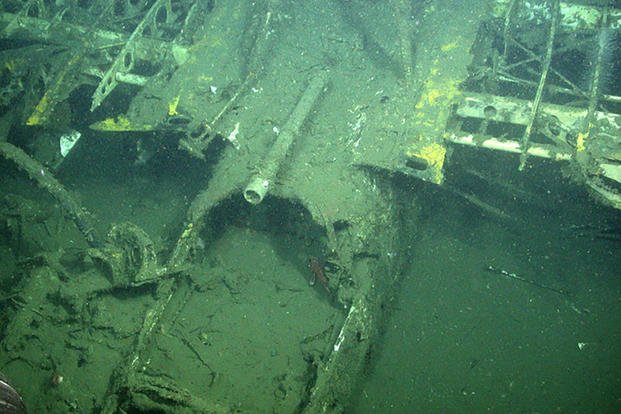On a late September day in 1931, more than 150,000 people flocked to Akron Municipal Airport to witness a spectacle. The air was abuzz with excitement as the USS Akron -- a 785-foot-long airship that was about 20 feet shorter than the Hindenburg -- flew for the first time.
More than 100 passengers, including Navy Secretary Charles Francis Adams, were afforded a bird's-eye view of the surrounding landscape in northeast Ohio as the rigid airship reached an altitude of about 1,000 feet during the four-hour tour.
"With the completion of the Akron, the United States resumes world leadership in lighter-than-air craft," said Rear Adm. William Moffett, the first chief of the Navy’s Bureau of Aeronautics who was onboard. "I feel sure she will demonstrate the great value of airships, not only for the Navy but for commerce."
Developed by the Navy's lighter-than-air program, the Akron and its sister ship, the USS Macon, were filled with helium and capable of becoming airborne without assistance from outside mechanical or technological systems, such as an engine. The program developed airships from 1915 until 1962, but what made these two dirigibles unique was that they represented the Navy's foray into the realm of flying aircraft carriers.
Not long after the Navy developed its first aircraft carrier, the USS Langley, in 1922, the military was eager to advance that concept into the skies to further assist its warships at sea with scouting and reconnaissance. Instead of taking off from the deck of a ship, aircraft would literally drop from above. Attached to a skyhook mechanism under the hangar, the aircraft would be lowered and released, and then when the plane's mission was complete, the skyhook would retrieve it in mid-air.
The first test flights occurred with a nonrigid dirigible, such as a blimp, in April 1917, the same month the U.S. entered World War I; one of those tests resulted in the airship being damaged beyond repair. That hardly swayed the program’s brain trust, though, as the Navy went on to commission four rigid airships of note.
All made history. The USS Shenandoah became the first rigid dirigible to fly across the U.S. and back in October 1924, and the USS Los Angeles made a record 331 flights and even once performed a handstand.
Then came the Akron and Macon, and Americans were kept abreast of their happenings through front-page stories and other news reports. When the Akron, which had a crew of 60 sailors and weighed 110 tons, went on a transcontinental adventure -- a journey that was tinged with tragedy when two sailors fell to their deaths while trying to dock the airship -- the country took note, as it did when the carrier went on patrols to Florida, Cuba and the Panama Canal.
There were other mishaps, too, and the Akron's service was interrupted by periods of downtime because of them. Eighteen months after its maiden voyage, the airship went down off the New Jersey coast during a violent storm. Moffett, the admiral responsible for the program, was among 73 killed in a tragedy that President Franklin D. Roosevelt termed a national disaster.

One of the three survivors, Akron executive officer Lt. Cmdr. Herbert Wiley, went on to lead the Macon's crew. Less than three weeks after the loss of the Akron, the Macon flew for the first time. Test flights in the South followed before the dirigible moved to California for fleet scouting tests and hooked up with the USS Houston as it transported Roosevelt from Panama to Hawaii.
The Macon’s upper fin was ripped off by excessive winds on Feb. 12, 1935, causing it to descend slowly into the waters off California. Because the Macon was equipped with life jackets and rafts -- potentially lifesaving items not onboard the Akron -- only two sailors died in the incident.

The sinking of the Macon ended the Navy's experiment with flying aircraft carriers, but not the service's work with dirigibles. During World War II, the Navy boasted five airship classes that operated in the Pacific, Mediterranean, and the north and south Atlantic. While those numbers dwindled after the war, the military still maintained two squadrons. The Navy announced it was closing its lighter-than-air program in 1961, which became official the following year.
Even as researchers have scoured the final resting places of the Akron and Macon in the decades since they went down, the idea of launching aircraft from the skies is not dormant. In the late 1940s, the Air Force conducted tests to launch the smallest fighter jet ever, called the Goblin, from a bomber but scuttled those efforts after a year. In 2019, the Defense Advanced Research Projects Agency, or DARPA, and defense technology company Dynetics announced the successful test of a drone that potentially could take off from and land in a plane such as the C-130 Hercules.
While flying aircraft carriers may have seemed futuristic at the time, they likely will remain relegated to U.S. military history – and in the imaginations of Hollywood scriptwriters.
Want to Know More About the Military?
Be sure to get the latest news about the U.S. military, as well as critical info about how to join and all the benefits of service. Subscribe to Military.com and receive customized updates delivered straight to your inbox.
















